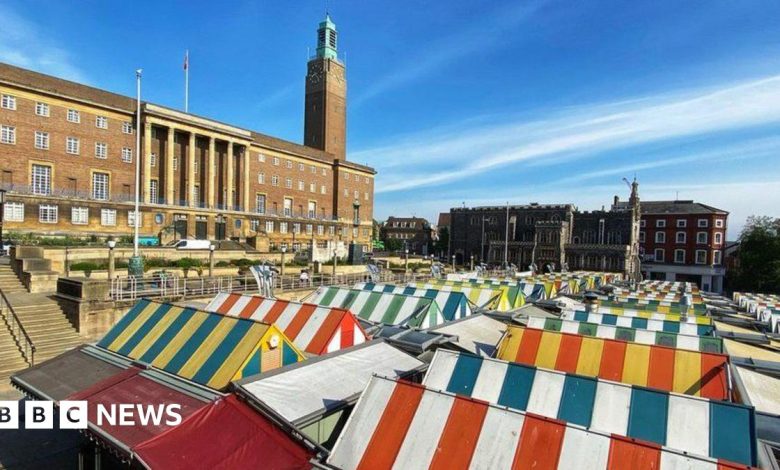Traders split over plans for shake-up of Norwich market

The historic marketplace in Norwich has been a hub of activity for over 900 years, with countless traders setting up stalls to sell their goods to the local community. However, as with any establishment that has been around for so long, the market is in need of some refurbishments to keep up with the changing times. Recently, Norwich City Council has proposed a major overhaul of the market, which has left traders with mixed opinions. Some traders, like Sophie Taylor, who runs a successful jewellery business, believe that a redesign is long overdue, citing that the market is “fairly dated in its current form”. On the other hand, some traders, such as Ray Harvey, who sells greeting cards, are concerned that an in-depth refurbishment could disrupt trade too much, potentially harming their businesses.
One of the key proposals put forward by the council is the addition of a central court to the site. This could potentially provide more space for traders to set up stalls, as well as create a more vibrant and welcoming atmosphere for customers. For traders like Sophie Taylor, this is a exciting opportunity to revitalize the market and attract more customers. She believes that a modern and updated market would be more appealing to locals and tourists alike, potentially leading to increased sales and growth for her business. On the other hand, traders like Ray Harvey are worried that the construction process could be disruptive, potentially forcing them to close their stalls for an extended period of time, which could have a negative impact on their livelihoods. It’s a delicate balance between preserving the historic character of the market and ensuring that it remains a thriving and relevant part of the community.
The Norwich marketplace has a rich history, dating back to the medieval period. Over the centuries, it has evolved and adapted to the changing needs of the community, with traders selling everything from fresh produce to handmade crafts. Today, the market is still a beloved part of the city, with many traders having been there for generations. However, as with any historic establishment, there are concerns about preserving its character while also allowing it to evolve and thrive. The proposed refurbishment has sparked a lively debate among traders, with some arguing that it’s necessary to ensure the market remains relevant, while others believe that it could potentially alter the very essence of the marketplace. For traders like Sophie Taylor, the prospect of a modernized market is exciting, but for others, like Ray Harvey, it’s a worrying prospect that could potentially threaten their livelihoods.
As the consultation process continues, traders are being encouraged to share their thoughts and opinions on the proposed refurbishment. The council is keen to hear from traders, customers, and members of the community, to ensure that any changes made to the market are in the best interests of everyone involved. For traders like Sophie Taylor, this is an opportunity to have their voices heard and to help shape the future of the market. She believes that the council is genuinely interested in listening to traders’ concerns and is willing to work with them to find a solution that benefits everyone. On the other hand, traders like Ray Harvey are more skeptical, worrying that the council may not fully understand the impact that the refurbishment could have on their businesses. As the debate continues, it’s clear that the outcome will have a significant impact on the future of the marketplace and the traders who rely on it.
Despite the concerns, many traders are optimistic about the potential benefits of the refurbishment. A modernized market could attract more customers, provide better facilities for traders, and help to preserve the historic character of the site. The addition of a central court, for example, could provide a vibrant and welcoming space for customers to relax and socialize, potentially increasing foot traffic and sales for traders. Furthermore, the refurbishment could also provide an opportunity to improve the market’s infrastructure, such as providing better lighting, sanitation, and storage facilities for traders. These improvements could make a significant difference to the daily lives of traders, making it easier for them to run their businesses and provide a better experience for customers.
In conclusion, the proposed refurbishment of the Norwich marketplace has sparked a lively debate among traders, with some welcoming the opportunity for modernization and others expressing concerns about the potential disruption to trade. As the consultation process continues, it’s clear that the outcome will have a significant impact on the future of the marketplace and the traders who rely on it. While there are valid concerns about preserving the historic character of the market, there are also potential benefits to be gained from a well-planned refurbishment. Ultimately, it’s crucial that the council listens to the concerns of traders and works with them to find a solution that balances the need for modernization with the need to preserve the market’s historic charm. By doing so, the marketplace can continue to thrive and remain a beloved part of the community for generations to come. The traders, like Sophie Taylor and Ray Harvey, will be watching the developments closely, hoping that the final outcome will be beneficial for everyone involved.








